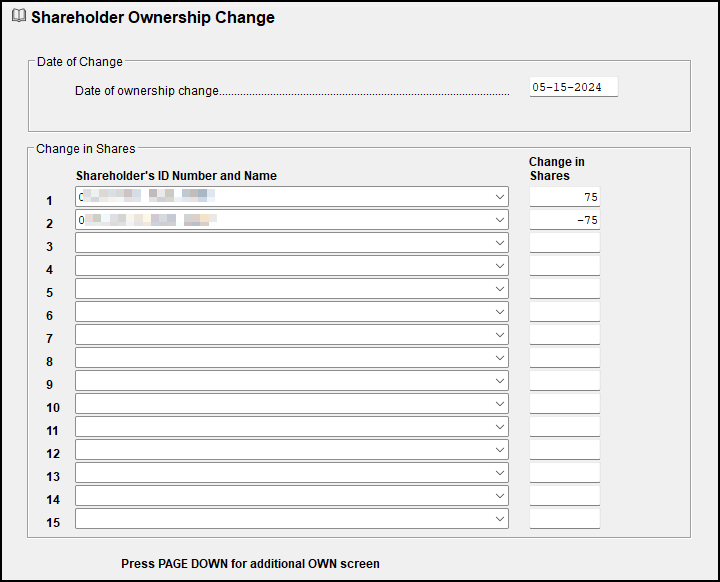Drake Tax - 1120-S: Shareholder Ownership Changes
Article #: 10604
Last Updated: December 05, 2024

In Drake Tax, S corporation ownership transactions are entered on the OWN screen:

-
Open the OWN screen and enter the first date of exchange in the Date of Ownership Change field. The date entered must be within the tax year.
-
Select the shareholders involved in the exchange from the Shareholder's ID Number and Name drop list.
-
In the Change in Shares field, enter that shareholder's changes of ownership. Use negative numbers to reduce the shareholder's interest; use positive numbers to increase it.
-
Repeat Steps 2 and 3 for all shareholders involved in the exchange.
-
Calculate the return.
-
Review the results. In View/Print Mode, review
-
the K-1 Wks Own page for each shareholder to verify that the percentages are correct. Use the calculated percentage to confirm that the K-1 amount for the shareholder presents the appropriate amount of income, deductions, etc. (To do so, multiply the Schedule K amount for each line by the calculated percentage.)
-
the Wks SOWN share information for each shareholder to confirm the correct year-end number of shares owned for each shareholder.
-
Notes:
-
The program calculates stock ownership changes for as many dates and exchanges as necessary. Press Page Down for a new screen for each date.
-
The sum of changes among multiple shareholders should net to zero, leaving the stock owned 100%, unless a shareholder received additional stock from the corporation, or returned stock (treasury stock) to the corporation. In that event, the exchange does not net to zero but the ownership is still 100%.
-
When an exchange involves more shareholders than one screen can hold, enter the same date in the new screen and continue selecting the shareholders involved. In this instance the individual OWN screens may not net to zero, but the entire exchange must net to zero.
-
The ending ownership amount may not equal the calculated ownership amount, as shown in this example:
-
Two shareholders each own 40 shares of an S corporation and a third owns 20 shares, to total 100 shares. The 20% shareholder decides to sell his interest to the other two shareholders on July 1. The two remaining shareholders' share of income, loss, deductions, etc., of the corporation is now 45% each for the year--not 50%. The 45% figure comes from the following equation:
-
(40% x 181 days/365 days) + (50% x 181 days/365 days)
The shareholder selling his interest will receive 10% of the S corporation's income, loss, deductions, etc., bringing the total allocation to 100%.